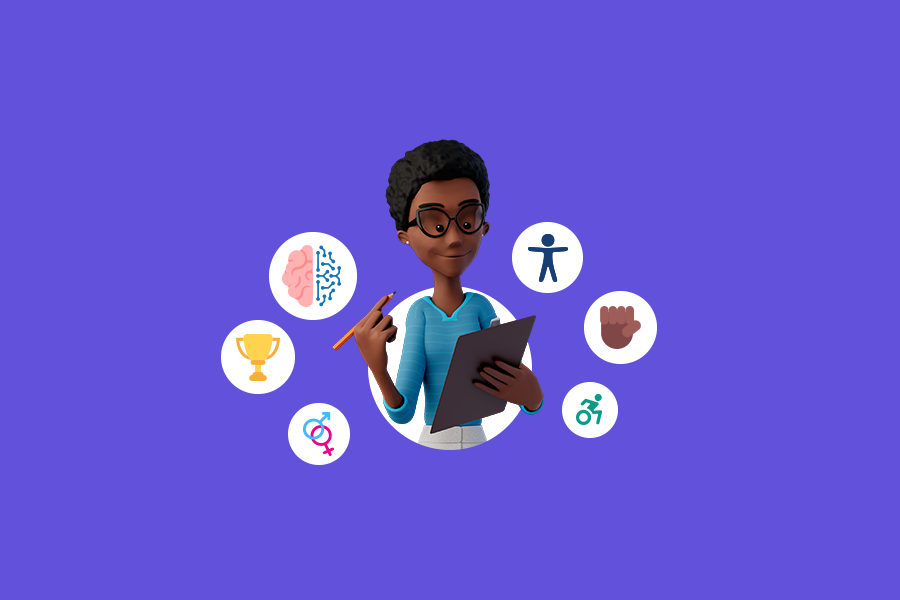
Inclusion in the workplace: what is it and why is it important?

The debate over diversity and inclusion in the job market is crucial for today’s corporate world. It is becoming increasingly common to find professionals who care about a company’s social stance, update their resume strategies to avoid discrimination when applying for jobs, and prefer employers who embrace inclusive policies.
To better address the demand for Diversity and Inclusion (D&I) practices, it is advisable to review the key insights about these concepts. Crafting tailored strategies to meet your organization’s initial needs and pave the way for gradual evolution is ideal.
What is inclusion in the workplace?
An inclusive job market offers opportunities for all individuals in paid activities. Even those with distinctive conditions should have access and active participation in the professional world.
This is a mindset that is still a work in progress in America. Did you know that only about 21% of people with disabilities are employed, while over 65% of those without disabilities have a paid occupation?
What is the difference between diversity and inclusion in the job market?
Diversity and inclusion are complementary approaches to people’s participation in the job market. To clarify the difference between the two concepts, we can say that diversity focuses on the “what” and inclusion addresses the “how.”
Diversity relates to demographic composition and societal groups that can (and should) be part of the professional workforce. Meanwhile, inclusion stems from efforts to provide fair and respectful access and integration for these individuals.
What is the importance of inclusion in the workplace?
The inclusion of diverse professionals holds increasing importance in today’s job market. In fact, it remains a strong global trend for the future of work worldwide. In other words, aligning with these concepts is crucial for staying competitive in the business world.
Diverse teams also contribute significantly to your company’s day-to-day operations. These teams tend to be more creative, as they comprise individuals with diverse worldviews and life experiences, contributing novel solutions and ideas for common goods or actions. So, how about delving deeper into how being an inclusive company can enhance people’s perception of your organization?
Plurality
Through the plurality of experiences and perspectives, your organization’s horizons will broaden, inspiring the pursuit of innovative, comprehensive, and viable solutions. And believe it or not, this will reflect in your financial performance.
Image strengthening
Efforts to provide a safe and accessible space for diverse professionals lead to greater recognition of the company’s values, aiding in strengthening both the internal and external images of your organizational culture.
Talent attraction and retention
Diversity and inclusion strategies in professional recruitment and inclusive actions in daily operations are competitive advantages in talent attraction. Moreover, they contribute to reducing personnel turnover.
What are the challenges for inclusion in the workplace?
D&I practices foster a sense of belonging and representation, promoting engagement and smoother work relationships. However, like all processes involving human resources, challenges must be overcome over time.
Misinformation and biased opinions are among the main concerns, whether due to unconscious prejudices embedded in our society’s structure or flaws in education, and less favorable cultural development conditions.
How to make the job market more inclusive?
Did you know that all Fortune 100 companies have committed to diversity, equity and inclusion initiatives? What was once an HR bottleneck is now a global trend that has even proven to be very profitable. Among the main recommendations are the following practices to enhance inclusion and the quality of people’s professional experiences:
Creating discrimination combat policies
Discriminatory biases are ingrained in American cultural heritage. Therefore, it is crucial to take responsibility for tackling them. One suggestion is to start by creating mechanisms that prevent the influence of prejudices, from selection processes to career plans within the company.
Guiding the leadership and management
Managers and leaders should have access to reliable information and appropriate training to implement D&I policies. This reinforces the idea that inclusion pertains to every person in the company.
Observing employee composition
To devise effective D&I strategies for a company, it is important to map the distribution of opportunities across all hierarchical levels and set goals to develop the organization’s inclusive profile, promoting diversity among teams.
Promoting the culture of diversity
Forming a diverse and inclusive culture depends on the sharing of ideas, experiences, and positive attitudes. However, merely discussing the topic is not enough to engage the team. The company must implement important measures, such as establishing a diversity committee and investing in accessibility resources.
What are the workplace accessibility types?
Workplace accessibility is a key requirement for the efficiency of diversity and inclusion practices in companies. Whether in physical or virtual environments, solutions should cater to people with reduced mobility and those with other disabilities, such as auditory, visual, intellectual, etc. Discover how to put this into practice in your organization and learn about the different types of accessibility.
Communicational accessibility
As the name suggests, the goal is to ensure accessibility for communication without barriers. This can be achieved through audio descriptions, subtitles, translations into ASL (American Sign Language), and other solutions.
Architectural accessibility
Access ramps for wheelchairs and adapted spaces for individuals with reduced mobility are examples of how architectural accessibility contributes to autonomy in the workplace.
Methodological accessibility
Methodological accessibility promotes inclusion through learning, employing techniques suitable for the education of individuals with disabilities.
Instrumental accessibility
Similar to architectural adaptations that facilitate movement through spaces, instrumental accessibility relies on tools and solutions that simplify life and overcome limitations through the use of objects necessary in daily life.
Attitudinal accessibility
Accessibility resides in attitudes as much as in technology or well-designed solutions. After all, empathy, respect, and acceptance also have the power to eliminate barriers between people.
Programmatic accessibility
Programmatic accessibility relates to inclusive norms and laws, with awareness, understanding, sensitivity, and respect for programs that promote and ensure the rights of individuals with disabilities.
How to address inclusion in the workplace?
Taking action instead of merely discussing workplace inclusion is important, but we do not want to downplay the significance of conversations about the topic. Far from it!
To achieve results with the recommended practices here, it is essential to foster awareness and dialogue, create space for questioning, encourage the use of inclusive language, and deepen knowledge about diversity and inclusion aspects in all social spaces.
Understand existing terminology and disabilities
Respecting differences is also reflected in the terminology used to refer to people or types of disabilities. Therefore, it is important to know the terms related to accessibility and understand what these expressions mean, as in the examples below:
- Hearing disability: clinically, it refers to individuals with mild to moderate hearing loss, which can be related to different types and degrees of a hearing disability. It is worth noting that these individuals typically do not identify with the Deaf culture.
- Deaf person: clinically, it is someone with profound deafness. However, the definition of a Deaf person has a significant cultural factor, as it involves proficiency in American Sign Language.
- Intellectual disability: it is a condition characterized by limitations in adaptive skills and intellectual patterns.
- Visual disability: refers to vision loss or severe limitations in visual acuity.
- Multiple disabilities: characterized by the combination of two or more types of disabilities. For example, a person who is blind and has an intellectual disability.
- Deafblindness: it is a multisensory disability, resulting from a combination of varying degrees of deafness and blindness that affects spatial perception.
Conclusion
Diversity and inclusion in the workplace play a crucial role in reducing social inequalities, and people are increasingly attentive to this issue. There is an urgency to align actions with intentions, transforming companies into more accessible and welcoming entities. While change might not happen overnight, it is wise to pay attention to the latest D&I trends and implement recommended practices sooner rather than later.


